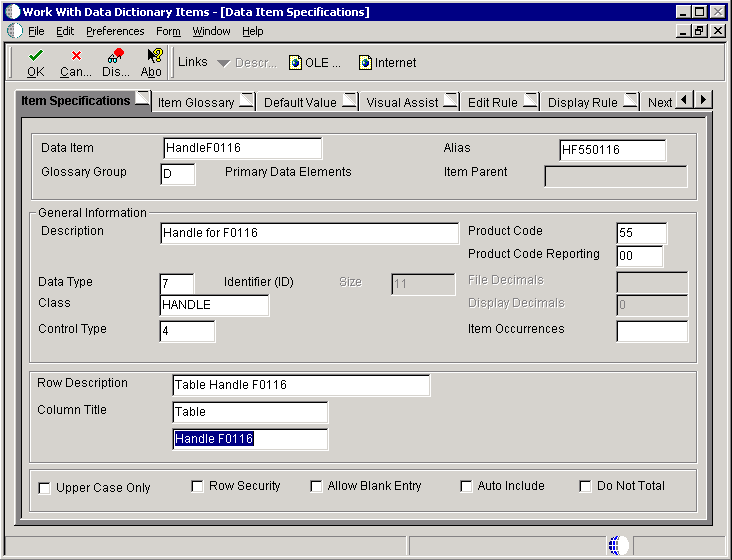Creating Handles
In JD Edwards Solution Explorer access EnterpriseOne Life Cycle Tools, Application Development, Data Dictionary Design, select Work With Data Dictionary Items to access the Work With Data Items form.

- Data Item
Enter the name of the data item. This is a 32-character alphabetical field that does not allow spaces or special characters.
- Alias
Enter a unique identifier.
- Glossary Group
Select a user-defined code (UDC) (H95/DG) that indicates the type of data item. A handle is glossary group D, Primary Data Elements.
- Description
Enter a meaningful description of the data item.
- Product Code
Select a UDC (98/SY) from the range of values reserved for clients: 55–59.
- Product System Code
Select a UDC (98/SY) that represents the JD Edwards EnterpriseOne system where the data is used. This value is used for reporting and jargon purposes. Example values include:
01: Oracle's JD Edwards EnterpriseOne Address Book
03B: Oracle's JD Edwards EnterpriseOne Accounts Receivable
04: Oracle's JD Edwards EnterpriseOne Accounts Payable
09: Oracle's JD Edwards EnterpriseOne General Accounting
11: Oracle's JD Edwards EnterpriseOne Multicurrency
- Data Type
Select the style or classification of data. Examples include, string, date, character, and identifier. A handle is an identifier data type.
- Size
Enter the field size of the data item.
- Class
Select a class that defines the essential attributes and characteristics of the data item. Examples include, name, email, and table handle.
- Control Type
Select the type of graphical user control that is associated with the data item. Examples include button, radio button, and user-defined code.
- Row Description
Enter the description of the data item as it will appear in a group report.
- Column Title
Enter the description of the data item as it will appear in a columnar report.